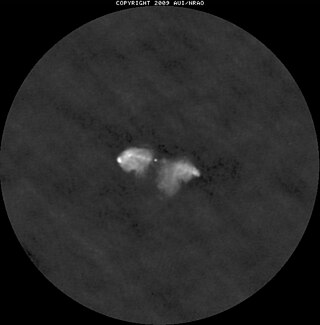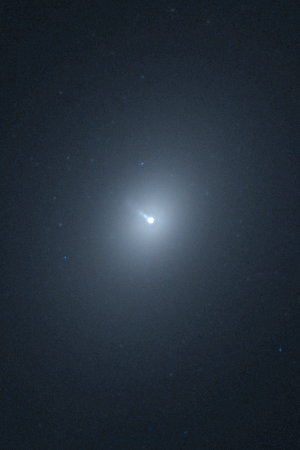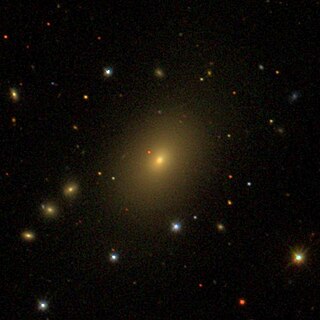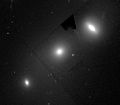
Centaurus A is a galaxy in the constellation of Centaurus. It was discovered in 1826 by Scottish astronomer James Dunlop from his home in Parramatta, in New South Wales, Australia. There is considerable debate in the literature regarding the galaxy's fundamental properties such as its Hubble type and distance. It is the closest radio galaxy to Earth, as well as the closest BL Lac object, so its active galactic nucleus has been extensively studied by professional astronomers. The galaxy is also the fifth-brightest in the sky, making it an ideal amateur astronomy target. It is only visible from the southern hemisphere and low northern latitudes.

3C 449 is a low-redshift Fanaroff and Riley class I radio galaxy. It is thought to contain a highly warped circumnuclear disk surrounding the central active galactic nucleus (AGN). The name signifies that it was the 449th object of the Third Cambridge Catalog of Radio Sources (3C), published in 1959.

3C 285 is a radio galaxy located in the constellation Canes Venatici. It is located about 1 bilion light years away. It is a Fanaroff-Riley 2 radio galaxy and is hosted in a disturbed spiral galaxy.

3C 438 is a Seyfert galaxy and Fanaroff and Riley class II radio galaxy located in the constellation Cygnus. The radio galaxy has two lobes and there is a radio jet leading to the south lobe, which also has a prominent double hot spot. There is age variation across the lobes.

NGC 3862 is an elliptical galaxy located 300 million light-years away in the constellation Leo. Discovered by astronomer William Herschel on April 27, 1785, NGC 3862 is an outlying member of the Leo Cluster.

NGC 7016 is an elliptical galaxy located about 480 million light-years away from Earth in the constellation Capricornus. NGC 7016's calculated velocity is 11,046 km/s. The galaxy has an estimated diameter of about 160 thousand light years and was discovered by American astronomer Francis Preserved Leavenworth on July 8, 1885. It is also host to a supermassive black hole with an estimated mass of 1.4 × 109M☉.

NGC 7469 is an intermediate spiral galaxy in the constellation of Pegasus. NGC 7469 is located about 200 million light-years away from Earth, which means, given its apparent dimensions, that NGC 7469 is approximately 90,000 light-years across. It was discovered by William Herschel on November 12, 1784.

NGC 541 is a lenticular galaxy located in the constellation Cetus. It is located at a distance of about 230 million light years from Earth, which, given its apparent dimensions, means that NGC 541 is about 130,000 light years across. It was discovered by Heinrich d'Arrest on October 30, 1864. It is a member of the Abell 194 galaxy cluster and is included in the Atlas of Peculiar Galaxies in the category galaxies with nearby fragments. NGC 541 is a radio galaxy of Fanaroff–Riley class I, also known as 3C 40A.

NGC 7674 is a spiral galaxy located in the constellation Pegasus. It is located at a distance of about 350 million light years from Earth, which, given its apparent dimensions, means that NGC 7674 is about 125,000 light years across. It was discovered by John Herschel on August 16, 1830.

NGC 545 is a lenticular galaxy located in the constellation Cetus. It is located at a distance of about 250 million light years from Earth, which, given its apparent dimensions, means that NGC 545 is about 180,000 light years across. It was discovered by William Herschel on October 1, 1785. It is a member of the Abell 194 galaxy cluster and is included along with NGC 547 in the Atlas of Peculiar Galaxies.

NGC 547 is an elliptical galaxy and radio galaxy located in the constellation Cetus. It is located at a distance of about 220 million light years from Earth, which, given its apparent dimensions, means that NGC 547 is about 120,000 light years across. It was discovered by William Herschel on October 1, 1785. It is a member of the Abell 194 galaxy cluster and is included along with NGC 547 in the Atlas of Peculiar Galaxies.

NGC 2110 is a lenticular galaxy located in the constellation Orion. It is located at a distance of about 120 million light years from Earth, which, given its apparent dimensions, means that NGC 2110 is about 90,000 light years across. It was discovered by William Herschel on October 5, 1785. It is a Seyfert galaxy.

NGC 7720 is an elliptical galaxy located in the constellation Pegasus. It is located at a distance of about 380 million light years from Earth, which, given its apparent dimensions, means that NGC 7720 is about 180,000 light years across. NGC 7720 is the main galaxy of Abell 2634 galaxy cluster and is a radio galaxy. It was discovered by William Herschel on September 10, 1784.

NGC 5532 is an elliptical galaxy located in the constellation Boötes. It is located at a distance of about 250 million light years from Earth, which, given its apparent dimensions, means that NGC 5532 is about 110,000 light years across. It was discovered by William Herschel on March 15, 1784. It is a Fanaroff–Riley type 1 (FR1) radio galaxy.

NGC 7236 is an interacting lenticular galaxy located in the constellation Pegasus. It is located at a distance of about 300 million light years from Earth, which, given its apparent dimensions, means that NGC 7236 is about 150,000 light years across. NGC 7236 forms a pair with NGC 7237 and is a radio galaxy. It was discovered by Albert Marth on August 25, 1864.

NGC 3801 is a lenticular galaxy located in the constellation Leo. It is about 150 million light years from Earth, and estimated to be about 170,000 light years in diameter. William Herschel discovered it on 17 April 1784.

NGC 2445 is a peculiar ring galaxy in the constellation Lynx. The galaxy lies about 200 million light years away from Earth, which means, given its apparent dimensions, that NGC 2445 is approximately 100,000 light years across. It was discovered by Édouard Stephan on January 18, 1877. The galaxy interacts with another galaxy, NGC 2444, and as a result its shape is distorted and new stars are formed.

NGC 1218 is a lenticular galaxy in Cetus that hosts the radio source 3C 78. It was discovered in 1886 by American astronomer Lewis A. Swift. It is located at l = 174.86, b = -44.51 in the galactic coordinate system.

NGC 5920 is a large lenticular galaxy located in the Serpens constellation. Discovered on March 30, 1887, by American astronomer Lewis Swift, NGC 5920 is 711 million light-years distant from planet Earth. It is a narrow-line radio galaxy and about 300,000 light-years in diameter.

NGC 2484 is a large lenticular galaxy located in the Lynx constellation. It is situated 560 million light-years away from the Milky Way, which given by its apparent dimensions, means NGC 2484 is around 304,000 thousand light-years across. It is classified a Fanaroff and Riley radio galaxy.





















